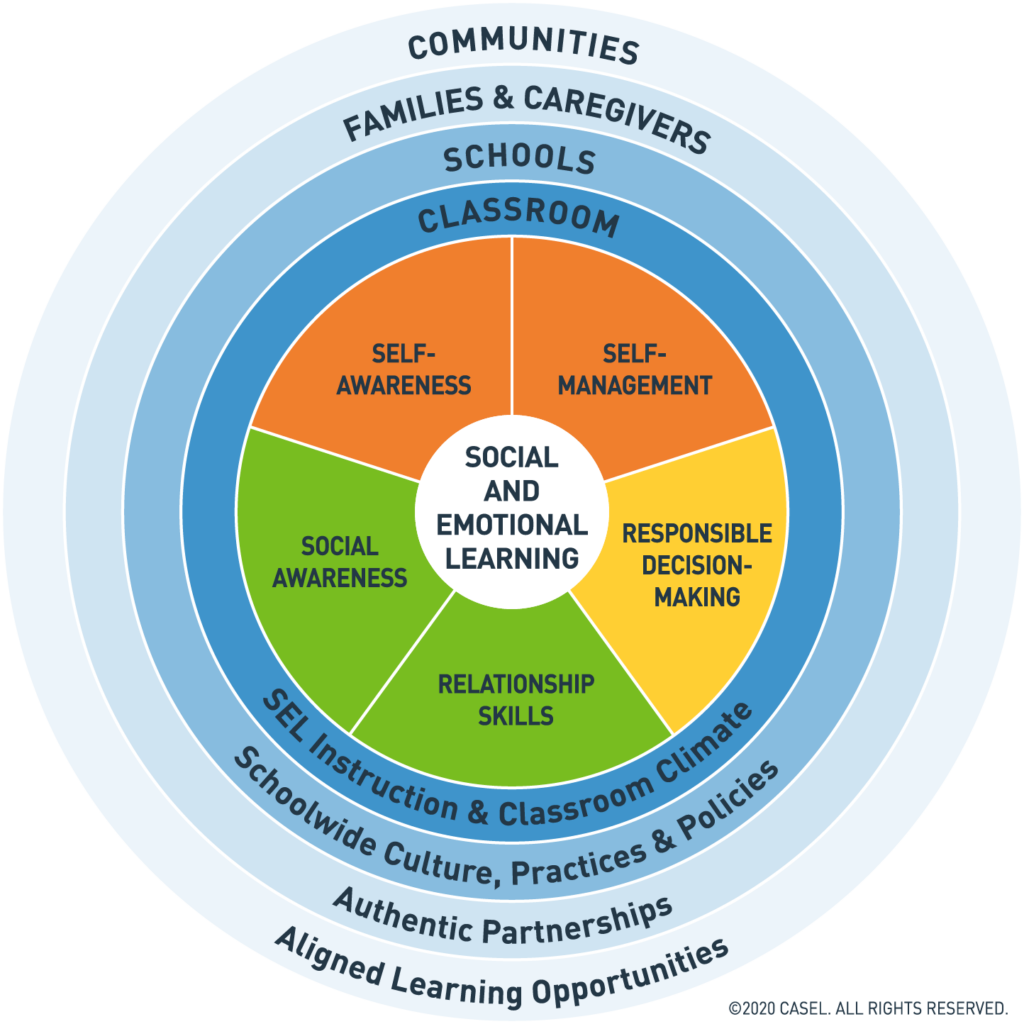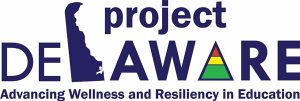What is Social and Emotional Learning?

Social and Emotional Learning (SEL) is “the process through which all young people and adults acquire and apply the knowledge, skills, and attitudes to develop healthy identities, manage emotions and achieve personal and collective goals, feel and show empathy for others, establish and maintain supportive relationships, and make responsible and caring decisions” (CASEL, 2021). Social and emotional learning provides the basis for the universal supports for behavior and wellbeing in the MTSS framework. There are 5 interrelated SEL competencies which exist across contexts and are integrated within the MTSS/SWPBIS framework in order to address the education of the whole child and facilitate their success in the classroom and the community. SEL can and should be used as a lever to address issues of equity in schools (e.g. NYSED, 2018). To see research on the benefits of SEL and the impact of SEL on students and adults, see the CASEL website.
SEL in Delaware
Social Emotional Learning has been a longstanding priority for the Delaware Department of Education. DDOE and stakeholders from districts, charters, schools, and community members, including members of the DE-PBS Project, partnered with the Collaborative for Academic, Social, and Emotional Learning (CASEL) in recent years to expand the integration of SEL throughout the state. This partnership led to the development of statewide SEL competencies, implementation resources, and creation of tools to support the integration of SEL into academic content areas. A practical Delaware SEL Toolkit is also available.
PBIS/SEL Alignment and Integration
Positive behavioral interventions and supports (PBIS) provides an ideal framework for promoting social emotional competencies to improve outcomes for the whole child.
- The DE-PBS SEL & SWPBIS Integration module reviews the SEL and SWPBIS approaches, provides a rationale for integrating SEL into a MTSS framework, and provides practical strategies to support integration in schools. The purpose of this module is to help school professionals deepen their understanding of these approaches, how they are complementary to one another, and how they can be integrated effectively to enhance student learning and development.
- The Teaching Social-Emotional Competencies within a PBIS Framework brief, from the Center on PBIS, describes how school personnel can teach social-emotional competencies within a PBIS framework to support systematic, school-wide implementation through one system, rather than trying to improve student outcomes through separate, competing initiatives.
- Integrating Social & Emotional Learning Within a Multi-Tiered System of Supports to Advance Equity: SEL MTSS Toolkit for State & District Leaders, has been developed by The Council of Chief State School Officers (CCSSO), in partnership with CASEL and the American Institutes for Research (AIR).
- The Social Emotional Learning: Cultivating Essential Life Skills – In this video interview presented by the Center on PBIS and PaTTAN, Kelly Perales from the Midwest PBIS Network explains the importance of deliberately and explicitly teaching SEL to students, how it can be integrated into a PBIS framework, and the benefits to students and educators alike.
- Building a Culture of Staff Wellness Through Multi-Tiered Systems of Support brief from Center on PBIS provides recommendations to district and school leadership teams on how the components of PBIS can be used to prioritize staff health and wellbeing.
- Integrating a Trauma-Informed Approach within a PBIS Framework practice guide from Center on PBIS describes how to integrate trauma-informed approaches into the PBIS framework to ensure efforts are linked to student outcomes. Strategies and tools to ensure effectiveness are included.
- Using MTSS to Keep SEL a Priority when Reopening Schools Webinar from DE-PBS walks through the “CASEL Initial Guide to Leveraging the Power of SEL as You Prepare to Reopen and Renew Your School Community” and provides insight on centering the planning of reopening schools by utilizing an MTSS framework.
- Developing Expectations and Behavior Matrix for Return to School Webinar from DE-PBS demonstrates how to update or develop a behavior matrix of school-wide expectations to teach new health precautions, learning expectations and prioritize social emotional competencies that will need to be taught when returning to school for in-person or remote instruction during the COVID-19 pandemic.
Additional SEL Resources
Mental Health and PBIS
The term ‘mental health’ refers to how we think, feel and behave; it is a critical part of our overall health (Center on PBIS, 2021). Mental health promotion is now recognized as a critical part of education, but schools struggle with how to establish a comprehensive system of mental health support. A school’s behavioral health program works best when its implemented within a tiered framework.
Tier 1: Primary Prevention (all)
At Tier 1, an integrated team of school-based and community-based clinicians focus on the social-emotional and behavioral needs of all students, often by teaching an evidence-based SEL curriculum school-wide. Data at this level include universal screening for both internalizing and externalizing concerns. Data are used to select evidence-based interventions within a continuum.
Tier 2: Secondary Prevention (some)
At Tier 2, those who have concerns follow a process to submit a request for assistance (see “Systems Development Tools” section here). Teams work to connect students to a range of targeted, group-based interventions. Clinicians coordinate and facilitate a continuum of supports to address social skills, problem-solving skills, and coping skills; including for those students who are experiencing anxiety, depression, and the impact of trauma.
Tier 3: Tertiary Prevention (few)
At Tier 3, clinicians coordinate individual interventions selected by the systems team. Teams monitor fidelity data and the interventions’ impact, regardless of who implements the intervention. Ongoing coaching, including professional development and technical assistance is provided.
MTSS and Mental Health Integration/Interconnected Systems Framework
Education and mental health leaders understand the need to establish one system of social-emotional and behavioral supports in schools. The Interconnected Systems Framework (ISF) is a way to blend PBIS with mental health supports in schools. This framework guides state, district, and community leaders to fund and modify policies and procedures to help every system work more efficiently. Clinicians – supported by integrated district structures – become part of multi-tiered school teams to address the social-emotional and behavior needs of all students. ISF expands the PBIS framework as a way to assist teams and enhance their efforts (Center on PBIS, 2021).
- To learn more, visit our page on MTSS and Mental Health Integration/ISF
Mental Health in Delaware

Project DelAWARE is a collaborative effort between the Delaware Department of Education (DDOE), The Division of Prevention and Behavioral Health Services (DPBHS), the UD Center for Disabilities Studies (CDS), the UD Center for Drug and Health Studies (CDHS), and three local school districts – Capital School District, Colonial School District, and Indian River School District. Funding for the project is provided through a 5 year federal SAMHSA (Substance Abuse and Mental Health Services Administration) grant.
The overarching purpose of Project DelAWARE is to implement evidence-based mental health services in school settings within the context of the Multi-Tiered System of Support (MTSS) in order to promote wellness and resilience for school-age youth and to improve access to mental health services.
With student mental health and suicide prevention being at the forefront of priorities, the DE-PBS Project has compiled helpful resources to implement suicide prevention, intervention, and postvention strategies within a multi-tiered system of support. See below to learn more about the relationship between school-based suicide prevention and MTSS; systems, data and practices needed for comprehensive school-based suicide prevention; and exemplars of suicide prevention strategies and programs at Tier 1, 2, and 3.
Resources
- Center on PBIS webinar Developing Comprehensive, Multi-Tiered School-Based Suicide Prevention
- Presentation Slides
- Helpful Resources from Battle Ground Public Schools
- Situating Mental Health Literacy Suicide Prevention within PBIS– This beneficial resource has a Slideshow presentation that reviews how Mental Health Literacy and Suicide Prevention can align with, as well as support, your PBIS program. (Retrieved from McDowell Institute, Bloomsburg University)
- Tier 1 Gatekeeper Training
- QPR Gatekeeper Suicide Prevention Training – Thanks to a state funded grant, NAMI Delaware is offering a free, 1-hour virtual training on how to recognize an individual who may be in a suicide crisis and how to guide them to proper treatment/services. QPR is a mnemonic that stands for Question, Persuade, and Refer to help you remember the 3 easy steps to helping a person who may be suicidal.
- Project DelAWARE and the Delaware Social Emotional Wellbeing (SEBW) Plan provide frequent opportunities for educators and community members to participate at no cost in a gatekeeper mental health literacy and suicide prevention training, Youth Mental Health First Aid. Contact Brynn Fallah (bfallah@udel.edu) for more information.
- Delaware Youth Suicide Prevention & Support
- 24/7 Youth Crisis Support 1-800-969-HELP (4357)
- Crisis Text Line: Text DE to 7471741
- Emergency Response: Dial 911
- The Delaware Division of Prevention and Behavioral Health Services (PBHS) has developed a toolkit that schools may use to promote youth mental health resources for families and students
- Division of Prevention & Behavioral Health Services Suicide Prevention Resources

Source: Center on PBIS: Developing Comprehensive, Multi-Tiered School-Based Suicide Prevention
